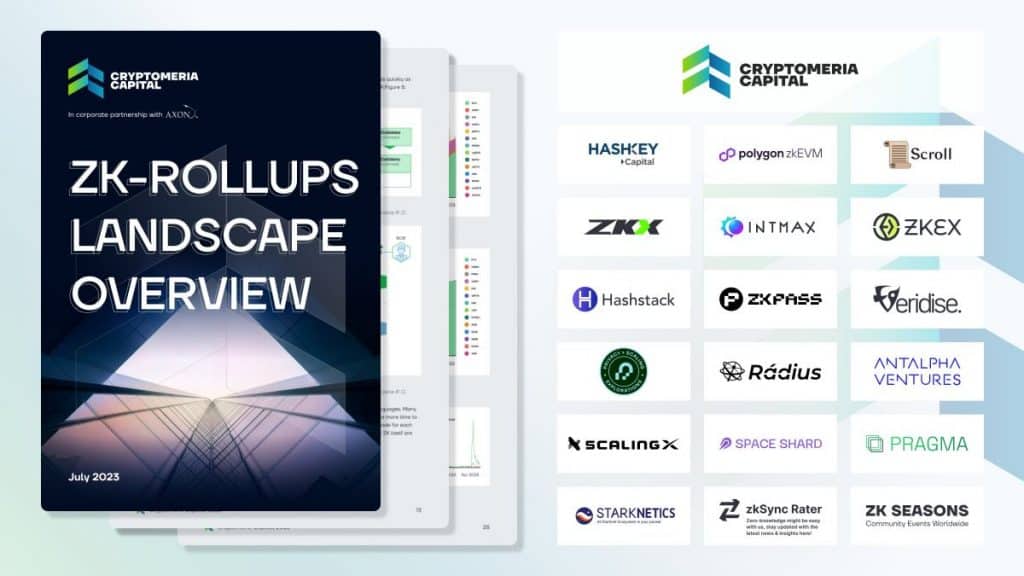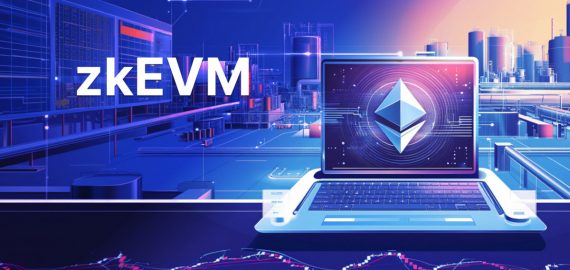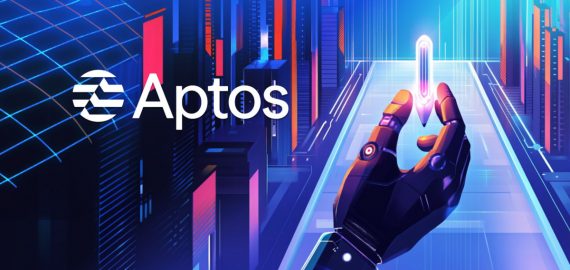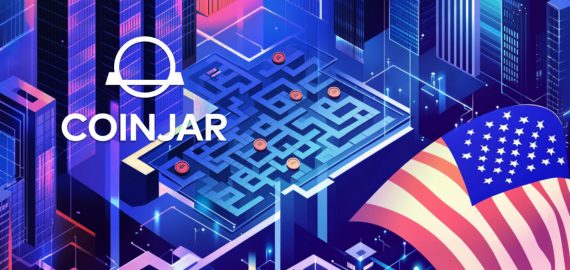Cryptomeria Capital’s ZK Rollup Report Highlights Competitive Landscape of L2 Solutions on Ethereum


In Brief
Cryptomeria has published its latest report, providing an overview of the ZK-rollups landscape.
The comprehensive 57-page report discusses the advantages and disadvantages of ZK-rollups, compares ZK-SNARK and ZK-STARK, and theorizes why ZK-rollups could become one of the strongest-performing sectors in blockchain this year.
The report also explains why optimistic rollups are currently leading in ecosystem development as compared to ZK-rollups.
Web3 investment firm, Cryptomeria Capital, has published its latest report titled “ZK-Rollups Landscape Overview.”

The comprehensive 57-page report discusses the advantages and disadvantages of ZK-rollups, compares ZK-SNARK and ZK-Stark, and theorizes why ZK-rollups could become one of the strongest-performing sectors in blockchain this year.
“ZK-rollups will enable private and secure off-chain transaction aggregation, reducing transaction fees, and improving transaction throughput. As demand for Ethereum scaling solutions continues to increase, ZK-rollups could become one of the strongest-performing sectors in 2023. This element of blockchain technologies will significantly change the overall crypto ecosystem, and will play a major role in the future of Web3, decentralized finance and the metaverse,”
Vadim Krekotin, founding partner at Cryptomeria Capital, noted in his letter to partners and investors.
What are ZK-rollups?
The origins of ZK-rollups can be traced back to a seminal paper published in 1989 by researchers from MIT. This paper introduced the concept of zero-knowledge proofs and presented key ideas such as the interactive proof hierarchy and knowledge complexity. It marked a significant milestone by providing the first zero-knowledge proof for a specific problem.
In 1993, researchers combined zero-knowledge and traditional proof theory, expanding the possibilities of these proofs. By 2017, Ethereum faced challenges in meeting transaction demands, leading to the exploration of scaling solutions like Plasma and Bulletproofs.
Despite the initial limitations of Plasma, it laid the groundwork for optimistic rollups, which aimed to improve scalability and security. In 2018, the concept of zero-knowledge rollups emerged, offering immediate transaction validity and fraud-proof guarantees. This sparked the development of projects such as zkSync and Starkware. However, zero-knowledge rollups required additional computational resources and separate tools for deploying smart contracts.
The journey of ZK-rollups from their origins to the development of optimistic rollups and zero-knowledge rollups demonstrates ongoing efforts to address Ethereum’s scaling challenges and optimize transaction efficiency and security.
ZK-rollups vs Optimistic rollups
Compared to ZK-rollups, optimistic rollups (OR) offered lower costs. By adopting an optimistic approach, they achieved cost efficiency and scalability. However, optimistic rollup users may experience a waiting period for Layer 2 to Layer 1 withdrawals to ensure chain safety and resolve any potential disputes.
OR operates optimistically, assuming most transactions are correct and generating fraud proofs only when disputes arise, while ZK rollups rely on complex zero-knowledge proofs. However, ZK rollups have drawbacks related to compilers and new programming languages, requiring developers to invest additional time and effort to build dApps on these platforms. Each block in ZK rollups requires separate calculations due to strict adherence to state transition rules, distinguishing them from Ethereum Virtual Machine (EVM) calculations.
After submitting a batch of transactions to Ethereum, OR introduces a waiting period of typically seven days during which transactions can be challenged. If a challenge occurs, fraud proofs are used to verify the absence of fraud. Longer waiting periods increase the likelihood of detecting incorrect data but also impact users with valid transactions. The theoretical risk of undetected incorrect charges or a 51% attack remains during the finalization of the desired state by malicious actors. These delays also reduce capital efficiency.
Both OR and ZK rollups employ permissioned sequencers to process transactions and create rollup blocks. However, OR relies on whitelists of validators, requiring a higher level of trust compared to other systems. Some solutions address withdrawal delays by providing funds against outgoing transactions, acting as liquidity providers. Optimistic rollups offer compatibility with Ethereum across different levels, from high-level RPC to low-level bytecode, making implementation relatively straightforward using tools like geth.
ZK proofs: ZK-SNARK vs ZK-STARK
ZK-rollups encompass two main types of zero-knowledge proofs: ZK-SNARKs and ZK-STARKs. ZK-SNARKs, well-established and widely used since the Zcash era, provide high-proof integrity and security. They have a strong developer community and offer assurances regarding their implementation. In contrast, ZK-STARKs are still undergoing active research and development, showcasing the potential for off-chain calculations and on-chain verification. They offer superior scalability and throughput but are more challenging and costly to verify compared to ZK-SNARKs.
ZK-STARKs demonstrate efficient scaling properties and inherent quantum resistance, safeguarding against potential threats from quantum computers. They do not require a trusted setup, enhancing their security and making them desirable for zero-knowledge proofs. On the other hand, ZK-SNARKs are exploring quantum resistance with developments like PQ-SNARKs, but practical implementation is still ongoing. Transparent SNARKs provide trustless alternatives, eliminating the need for a trusted setup and promoting decentralization.
While ZK-STARKs offer advantages in terms of scalability and security, their proofs occupy substantial memory compared to ZK-SNARKs. Efforts are underway to reduce STARK-proof sizes. Despite this, SNARKs tend to require approximately four times less gas than STARKs, even though STARKs may involve more packetized data. These factors contribute to the ongoing exploration and utilization of both ZK-SNARKs and ZK-STARKs in addressing Ethereum scaling challenges and optimizing optimistic rollup solutions.
Conclusion
The report concludes that optimistic rollups are leading the race among Layer 2 (L2) solutions on Ethereum, boasting the largest Total Value Locked (TVL) and a thriving ecosystem. These rollups offer native compatibility with the Ethereum Virtual Machine (EVM). However, they do face limitations in terms of bandwidth and security compared to Zero-Knowledge (ZK) solutions. Starkware and zkSync emerge as the top contenders among ZK solutions, with well-established ecosystems and toolkits. Yet, they also come with the challenge of architectural and development complexity. On the other hand, Scroll and Polygon zkEVM are actively working on improving EVM compatibility.
The current landscape highlights the success of optimistic rollups, showcasing their benefits of EVM compatibility and cost-efficient transactions. Meanwhile, ZK-rollups represent the next significant milestone in the advancement of layer-2 solutions for Ethereum.
Disclaimer
In line with the Trust Project guidelines, please note that the information provided on this page is not intended to be and should not be interpreted as legal, tax, investment, financial, or any other form of advice. It is important to only invest what you can afford to lose and to seek independent financial advice if you have any doubts. For further information, we suggest referring to the terms and conditions as well as the help and support pages provided by the issuer or advertiser. MetaversePost is committed to accurate, unbiased reporting, but market conditions are subject to change without notice.
About The Author
Cindy is a journalist at Metaverse Post, covering topics related to web3, NFT, metaverse and AI, with a focus on interviews with Web3 industry players. She has spoken to over 30 C-level execs and counting, bringing their valuable insights to readers. Originally from Singapore, Cindy is now based in Tbilisi, Georgia. She holds a Bachelor's degree in Communications & Media Studies from the University of South Australia and has a decade of experience in journalism and writing. Get in touch with her via [email protected] with press pitches, announcements and interview opportunities.
More articles

Cindy is a journalist at Metaverse Post, covering topics related to web3, NFT, metaverse and AI, with a focus on interviews with Web3 industry players. She has spoken to over 30 C-level execs and counting, bringing their valuable insights to readers. Originally from Singapore, Cindy is now based in Tbilisi, Georgia. She holds a Bachelor's degree in Communications & Media Studies from the University of South Australia and has a decade of experience in journalism and writing. Get in touch with her via [email protected] with press pitches, announcements and interview opportunities.

















































